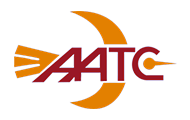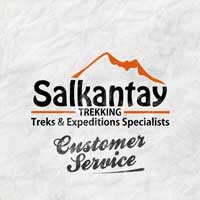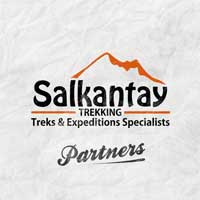The Ultimate Choquequirao Packing List Tour Guides
Congratulations! You’ve decided to join Salkantay Trekking on the adventure of a lifetime to the Choquequirao archeological site.
Of course, you must be feeling very excited and eager to get out on the route. But, you need to make sure you take the right gear with you. Not sure what you need exactly? Don’t worry…
Below, we’ve put together a very detailed ultimate packing list for the Choquequirao Trek. This info will help you prepare for your epic adventure and make sure you enjoy it to the max in comfort.
In our packing list, you’ll find very detailed descriptions of why you need the items to enjoy a safe and fun trip as well as some top brand recommendations. We use this gear ourselves and are big fans of how comfortable it keeps us on the routes. Our suggestions are what we believe offer the best value for money and top performance.
Keep reading to find all the items you need for the Choquequirao Trek.
In our packing list, you’ll find very detailed descriptions of why you need the items to enjoy a safe and fun trip as well as some top brand recommendations. We use this gear ourselves and are big fans of how comfortable it keeps us on the routes. Our suggestions are what we believe offer the best value for money and top performance.
Keep reading to find all the items you need for the Choquequirao Trek.
The Essential Packing List for Trekking Choquequirao
Documents
Original Passport
You’ll need your original passport to get into Peru, but you need to carry it with you most of the time. To trek Choquequirao, you need to make sure you take your passport. Ensure that the details you give us when booking are exactly the same as on your passport.
If you do one of the Choquequirao Treks that end at Machu Picchu, the same applies. You won’t be able to enter the site without it.
Backpack and Duffle Bag
Backpack
So, you don’t need to carry your duffle bag along the routes, but you do need to take a lightweight backpack for the essentials you need during the day—snacks, water, camera, sunscreen, etc.
For ultimate comfort, we propose a backpack with compression straps to decrease weight stress on your back, and side mesh pockets for easy access to your water bottle. The Osprey Talon is our top pick backpack.
It’s important you bring a rain cover for your rucksack as you never know when there’ll be a downpour in the Andes. If you decide to use an Osprey backpack, then make sure you get an Osprey Raincover that matches the bag size for a perfect fit.
Duffle Bag (included in the service)
At your briefing the evening before the trek, we’ll provide you with a small duffle bag. This is for you to pack all your clothes and other bits and bobs you need for the entire trek. You get up to 7 kg/15.4 lbs weight allowance.
Our horseman will take your duffle bag for you along with the food and camping equipment on the entire route. It’s important to mention that you won’t have access to your things in the duffle bag until the end of each day at the campsites—the horsemen and horses will always be in front of the group.
During the day, you need a backpack big enough to take your personal items—raincoat, camera, sunscreen, snacks, water, etc. A 20 or 30-liter backpack is usually sufficient.
Clothing
Underwear
Perhaps the most important layer of clothing is your underwear. It has direct contact with your skin, so you need to be breathable and extra comfortable. Take enough for the number of days your trek lasts and an extra pair or two. Breathable sports underwear is the best.
We can’t get enough of Icebreaker underwear, Adidas sports underwear, or Under Armour underwear, as these labels particularly focus on manufacturing products that can cope with sweat from high-intensity exercise and sports.
Trekking Shirts
You’ll need at least one trekking shirt per day of your hike. Breathable and lightweight models are the best for comfort, such as these shirts from Hanes. Alternatively, shirts from Icebreaker or Columbia are also of high quality.
Don’t take cotton shirts because these absorb moisture and can lead to you feeling very uncomfortable. A mixture of short and long sleeve shirts is recommended for the varying climates.
Hard Shell Jacket and Rain Gear
Rain is always a possibility if you’re hiking in Peru. The climate is unpredictable, and during the rainy season, you can expect some heavy downpours. You should bring a hard-shell jacket for ultimate protection when it’s the wet season, like the North Face Resolve Jacket.
It’s also worth taking a compact rain poncho that can immediately be put on should you encounter a light downpour.
Fleece Jacket
The Choquequirao Trek doesn’t get as chilly as some of the higher altitude treks, but it’s still a good idea to take some warm clothing. As an insulation layer, we recommend something made from fleece material.
We love the Polartec 200 Fleece Jacket. These insulation layers are remarkably good for hiking as they provide excellent warmth to weight ratio while providing effective moisture transfer. The Polartec 100s are lighter but not warm enough for the Choquequirao Trek, whereas the Polartec 300s are too heavy, in our opinion.
Some of our top pick fleece brands include Helly Hansen, The North Face, and Patagonia.
Trekking Pants and Shorts
For extra comfort, you’ll need hiking shorts or pants. There are many brands to choose from, but we love Craghoppers, Columbia, and O’Neills.
You may even want to opt for convertible pants like this trekking model designed by Craghoppers. Not only will they save you money as you won’t need to buy shorts, but they’re also super comfy.
Pajama Pants
At the end of a long day of hiking, you’ll want to relax in pure comfort. Take sweatpants or pajama pants for comfort and to be cozy in your bed at night. It can get colder in the evenings, so make sure they’re warm.
Gloves
If you feel the cold a lot, you might want to consider some gloves for the evenings and early mornings. They act as a shield from the cold and need to be warm, waterproof, and durable. Gore-Tex gloves from Dakine or similar options from The North Face, Outdoor Research, or Black Diamond are recommended.
Headgear
Hat for Sun Protection
You need to bring a hiking hat that gives you face and neck protection from the glaring sun. At high altitudes like this, it’s easy to get burnt in a very short period.
Your hat should be light and easy to bend/fold so that it can easily be put into your backpack or rucksack. Trekking hats with a neck cover are fantastic to give you ultimate protection.
Headband or Beanie
In the evenings and early mornings, the temperature can get pretty low. A warm fleece beanie or fleece headband are absolute must-haves. Berghaus and The North Face provide some fantastic beanies that are ideal for trekking in the cold.
Footwear
Hiking Boots
One of the most essential items on your trek packing list should be a quality pair of hiking boots. After all, your feet are what get you from A to B.
If you have badly fitting boots or don’t use worn-in footwear, you can suffer damaged toenails, painful blisters, and all-around sore feet.
To find the best fit, put your foot in a boot without tying the shoelaces. Once in, slide your foot all the way forward until the toes hit the front of the boot. You should be able to put your index finger down the back of the boot between your heels. If your finger has plenty of room to move then the shoe is too big, but if you find it difficult to get your index finger into the boot then the shoe is too small.
Here are some recommended and reliable brands of the best hiking boots: Scarpa, Salomon—we like the Quest range—, Berghaus—we like the Explorer range—, Hi-Tec, and Karrimor.
Sneakers (Trekking Shoes/Sandals)
After a long day of hiking across rugged terrain, the first thing you’re going to want to do is to change into a comfy pair of shoes. We advise bringing trekking shoes, sneakers, or sandals. We like Merrel trekking shoes, and trekking sandals are great to wear with warm socks for optimum comfort.
Hiking Socks
You’ll need a few pairs of hiking socks and a few pairs of high-wicking sock liners.
We recommend Coolmax hiking socks as they provide excellent breathability and have fantastic wicking characteristics. Smartwool, Bridgedale, and Point 6 also make great socks.
Don’t bring cotton socks, as these can lead to nasty blisters and sweating.
Gaiters
Gaiters are made from waterproof material and extend up from your boot to the top of your calf.
Trekkers wear gaiters to stop water, dust, mud, snow, ice, and small stones from getting into your hiking boots.
Sleeping Bag
Sleeping Bag
Whichever trek you come on with us, you’ll need to take a warm sleeping bag. The nights can get pretty chilly even at lower altitudes.
The best types of sleeping bags are manufactured using a duck or goose down, but they also tend to be the most expensive. If you’re stretched for cash, a warm synthetic alternative is fine. Just make sure that it has a rating of at least -10°C.
Look out for a sleeping bag that has a mummy shape with an insulated hood and drawcord so that it fits the contours of your body. Two-way zippers for better insulation are great.
We recommend the following brands and models: The North Face Snow Leopard, Marmot Trestles, Mountain Hardwear Phantom Highlander, or Coleman.
Important Accessories
Trekking Poles
When you ascend and descend, the pressure on your knees and ankles is a lot and it can be painful at the end of the day. Top-quality walking poles can reduce the force on your knees and leg joints by up to 20 percent.
We recommend getting light-weight (around 350 grams per pair) and adjustable trekking poles, as they are simple to store and very versatile. Black Diamond walking poles are fantastic, as are Leki poles.
Sunglasses
In Cusco, Peru, and nearby regions, you’re at a very high altitude. This means that the UV intensity is particularly high.
You should bring a great pair of UV protection sunglasses (minimum of 80% light reduction). We suggest mountain sunglasses from Julbo.
Flashlight or Headlamp
You won’t be walking at night, but sometimes you need to go to the toilet in the dark or like to read before bed. Many of the teahouses and campsites are poorly lit or have no electricity at all, so extra lighting is very helpful.
Petzl Tikka is the best headlamp brand. Don’t forget to bring spare batteries as well.
Water Bottle or Hydration Bladder
At high altitudes, it’s much easier to get dehydrated. Every day, you should aim to drink 2–3 liters of water. Heatstroke and dizziness are common for dehydrated trekkers and could cause you to miss the rest of your hike.
Water can be carried in a standard water bottle—we advise getting 2 x 1L CamelBak Water Bottles.
Or, if your daypack includes a place for a hydration bladder, then the 2L Platypus Hydration Bladder is an excellent product.
Camera
The scenery in Cusco, Peru, is astounding! You’ll surely want to capture your experience in HD, so if you don’t have a nice camera, now’s the time to get one.
Here are some recommended and affordable Digital SLR cameras. Remember, you want to make sure your camera is light but still able to take high-quality images. We like the Panasonic Lumex. If you’re more inclined to take videos, then you might want to consider the GoPro.
Notebook/Journal & Pen
This isn’t a must but is a great way to chronicle your trek so you remember every aspect possible.
Personal Gear and Medication
-
Swimsuit
If your trek goes to Machu Picchu and you plan on taking a dip in Aguas Calientes hot springs, this is a must. On some routes, there are also opportunities to swim.
-
Trekking Towel
A small to medium-sized hiking towel can come in very useful. LifeVentures or Discovery provide good, quick-drying trekking towels.
-
Cash
Along the route, there are spots to buy snacks and water. It’s also a great idea to have extra cash (S/300–S/400) in case of an emergency.
-
Toilet Paper
You might need to go to the bathroom during the day. You’ll need toilet paper as most toilets don’t usually provide this.
-
Portable Power Pack
Although there are opportunities to charge devices on some treks, a portable power is a great idea so you can charge anytime, anywhere.
-
Small Locks
To protect your belongings in your backpack or duffle bag.
-
Waterproof Ziplock Bags
These come in handy for storing important/valuable items like your money, passport, and electrical equipment
-
Isotonic Powder
Can be used to flavor your water and helps replace electrolytes, improving energy levels and aiding water absorption.
-
Diamox
Also known as acetazolamide, this is a medication that can be used as a prophylactic (preventative) solution for altitude sickness. It does not cure altitude sickness and should never, therefore, be used as a method to continue ascending to high altitudes. It can, however, help stop the onset of altitude sickness and is often used by high altitude climbers and trekkers.
-
General Medications
We recommend taking paracetamol or aspirin for headaches (a common altitude sickness symptom on the Salkantay Trek) and Imodium for diarrhea.
-
Basic First Aid Kit
If you’re joining an organized trek, your guide will most likely be carrying a first aid kit. If you’re hiking unsupported or independently then a first aid kit is a must.
-
Sunscreen/Lip balm
No one enjoys burnt skin or cracked lips. Be sure to bring 1 x sunscreen (SPF 50+) and 1 x lip balm.
-
Bug Spray/Repellent
As you get closer and closer to Machu Picchu, you’ll come across more bugs that like to bite! You’ll need this to keep them away.
-
Baby Wipes/Body Wipes
For quick and easy wet washes when no showers are in sight! Bring 1 x baby wipes or body wipes.
-
Blister Plasters
The dreaded blisters! We recommend taking Compeed blister plasters
-
Hand Sanitizer
Great for disinfecting hands before and after eating, or when they get dirty during the hike.
Find the Perfect Destination in Peru
With astonishingly varied landscapes, stunning scenery, compelling history, and a legacy of fascinating cultures, there is truly something for everyone. Our expeditions in Peru are designed to showcase all that this country has to offer.
Our expeditions in Peru are designed to showcase all that this country has to offer.










